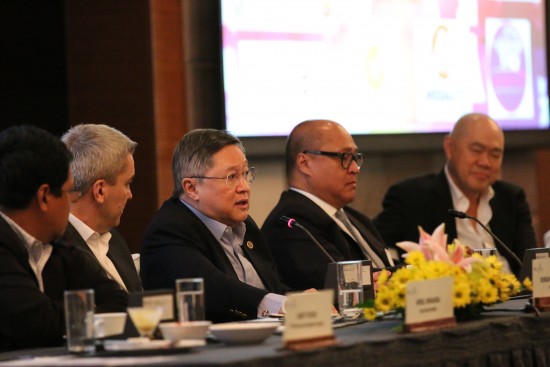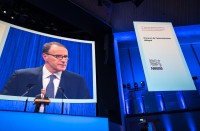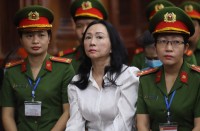
(Eagle News) — The Philippine economy grew a solid 6.8 percent in 2016, surpassing even China, and considered one of the fastest rates in Asia last year.
Data provided by the Philippine Statistics Authority showed that the Philippine economy was even faster that China (6.7 percent), and Vietnam (6.2 percent) reflecting the fastest Gross Domestic Product growth in Asia.
Finance Secretary Carlos Dominguez III said that this proved that the economy is in “pretty good shape” under the leadership of President Rodrigo Duterte, even as he had grabbed international headlines for his tirades and bristling straight-to-the-point remarks.
In 2015, the country’s economy under the Aquino administration grew by 5.9 percent.
“This is clear proof that no amount of counterproductive political chatter from certain quarters could undermine the upward trajectory of a domestic economy that is in pretty good shape under a Duterte presidency that is fully committed to sustaining its growth momentum,” Dominguez said in a statement.
Dominguez said the strong GDP growth in 2016’s second semester is a strong incentive for the Duterte administration to go ahead on further reforms, such as improving the ease of doing business and lifting constitutional and regulatory barriers to foreign direct investments (FDIs), that would attract more private capital and spur even faster economic expansion.
The finance chief said the Philippine economy is well on its way to sustaining its growth momentum over the medium term, on the back of the Duterte administration’s bold initiatives to keep it on its upward trajectory despite global market volatility.
-Comprehensive Tax Reform Package to be pushed –
He said this gives the Department of Finance (DOF) all the more reason to aggressively engage in its proposed Comprehensive Tax Reform Program (CTRP)—and the Congress to swiftly act on it.
This is so the government could raise enough funds for its “unparalleled” public spending program on infrastructure, human capital and social protection that would keep the Philippines among Asia’s fastest-growing economies in the years ahead, he said.
According to Undersecretary Gil Beltran, while the outlook for the Philippines remains robust, more investments in both physical and social capital have to be mobilized to support and sustain the growth, make growth more inclusive, and eradicate poverty. Poverty rate was brought down from 25.2 percent in 2012 to 21.3 percent in 2015.
Beltran, the DOF’s chief economist, said reforms to support growth include, among others, fiscal reforms in general and tax policy and administrative reforms in particular.
“The proposed tax reform seeks to flatten and make simpler the structure (thereby making tax administration simpler) and broaden the tax base (increasing revenue intake), he said in the DOF’s latest economic bulletin. “The increased efficiency in domestic resource mobilization will help bankroll inclusive development programs, an avenue for greater economic enfranchisement especially for the underprivileged. Furthermore, strong macro-economic fundamentals have to be maintained to foster stability and enhance investor confidence in the country.”
The CTRP’s Package One—as contained in House Bill No. 4774 authored by House ways and means committee chairperson Rep. Dakila Carlo Cua—provides for personal income tax (PIT) cuts plus revenue measures to make up for the foregone earnings from the would-be lower PIT rates.
Domingo said the economy is well positioned to grow between 6.5 percent to 7 percent this year. This is as projected by most international and local financial institutions and experts.
This is given “the government’s resolve to further strengthen its macroeconomic fundamentals and maintain solid buffers to cushion the effects of global unknowns like the coming US Federal Reserve hikes and inward-looking or protectionist policies by certain countries that could undermine international trade.”
Dominguez said the Philippine economy is founded on, among others, record dollar reserves, strong revenues from the business process outsourcing (BPO) sector and remittances from migrant Filipinos, high domestic consumption, declining debt, low inflation and solid credit ratings.
He said the continued strong performance of the local economy in the first six months of the Duterte presidency—7.0 percent over the July-September period and 6.6 percent in the fourth quarter—underlines “the strong confidence of the business community in the Duterte presidency’s commitment to sound fiscal management and further reforms to sharpen the economy’s global competitiveness, attack poverty and achieve economic inclusion.”
“The fast GDP expansion has buoyed government expectations of meeting its growth targets in 2017 and, with the hoped-for timely congressional approval of the first package of the CTRP, of sustaining its ambitious inclusive-growth agenda to attract more investments, create enough jobs, reduce the poverty incidence by almost half, and transform the Philippines into an upper middle-income country by 2022,” Dominguez said.
The PSA reported on Thursday morning that the GDP grew 6.8 percent in 2016 from 2015’s 5.9 percent and 6.6 percent year-on-year in the fourth quarter from 2015’s 6.5 percent.
In a report, the PSA said that the manufacturing, trade, and real estate, renting and business activities were the main drivers of growth in 2016’s fourth quarter.
The Philippine economy grew by 6.6 percent year-on-year in the final quarter of 2016, a slight slowdown from the previous three months but still one of the fastest rates in Asia.
This reflected many of the strong fundamentals put in place by Duterte’s predecessors, as well as the continued importance of remittances sent home by the roughly 10 million Filipinos working overseas.
“Actually the strategies have been there before. We just now need to accelerate,” Socioeconomic Planning Undersecretary Rosemarie Edillon told reporters.
The government said it planned to more than double infrastructure spending — from $17 billion this year to $36.8 billion in 2022 — with the Philippines looking to China and Japan rather than the United States to finance the plans.
“In terms of funding, we are not going to depend much on the US, we are going to get it from the (Asian) neighbourhood,” Socioeconomic Planning Secretary Ernesto Pernia said.
The Philippines also expects to open up important new export markets in China and Russia, and see a huge influx of tourists from those countries, according to Pernia.
He expressed confidence the economy would grow this year at the upper end of the government’s target of 6.5-7.5 percent, then between seven and eight percent for the rest of Duterte’s six-year term.
UK-based research firm Capital Economics cited the “uncertain political situation” in the Philippines as a downside risk to its
economy, along with a potential loss of trade from the United States due to President Donald Trump’s protectionist policies.
But it maintained its forecast that the Philippine economy would grow 6.5 percent this year.
(with a report from Agence France Presse)







